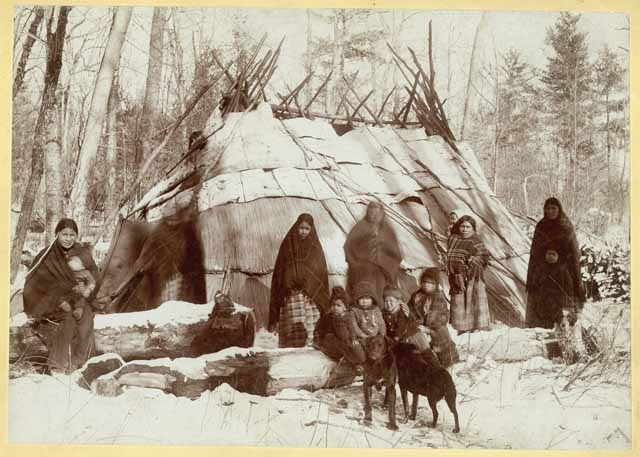The Native Americans were very diverse in their survival means. I live in Northern Michigan and most of the tribes native to this area headed away from the lake to their inland winter camps, most of them farther south in the state. They built winter lodges of birch bark that were up to twenty feet long and ten feet wide. As many as three generations of a family would live in the lodge all winter. Typically there would be a firepit at each end, one to cook over and one for warmth.
The Native Americans in this area were farmers. They collected the wild rice in season, but also cultivated and grew corn, beans, squash, and other vegetables they stored for winter survival. These weren't small patches, but acres of fields tended by the women all summer long. It was enough - at least in the good years - to see them through the winter.
Keeping warm was a full-time occupation. They coated their skin with bear and goose grease. This both repelled moisture and retained heat. They also wore animal skins tanned with the fur on, but unlike fur coats of today, they wore them with the fur against their skin for added insulation and warmth. Huge blankets were made of rabbit skins sewn together and used to cover several people, thus keeping in more body heat on cold nights.

As well as keeping warm, they needed to keep busy. During the summers they were tending their crops, gathering wild edibles, hunting, and fishing. During the winters, men still hunted, fished through the ice, and trapped animals for their warmest furs. The women did the handwork needed for the next summer, including making clothing and decorating it, making baskets, carving bowls, and - of course - tending to the children.
It wasn't an easy existence. It makes me appreciate my snug house with its wood heat and insulated windows.
 Pegg Thomas writes "History with a Touch of Humor."
Pegg Thomas writes "History with a Touch of Humor."


That’s fascinating! I can’t evwn imagine. It’s so cold here in Maine.
ReplyDeleteCold here too. Looks like we won't hit double digits this coming week unless there's a negative in front of them. Brrr!
DeleteResourceful People. Thanks for enlightening us!
ReplyDeleteThanks for stopping by!
DeleteAmazing how people adapt in different situations. Thanks for the great post.
ReplyDeleteIsn't it? Can you imagine anyone today surviving like this?
DeleteI've often thought about this. Sometimes, burning wood to heat our home, I feel like keeping warm is still a full time job, but can you just imagine it without the use of modern tools like chainsaws and woodsplitters? Or even a truck to haul it in? Ugh!
ReplyDeleteWe heat with wood as well, and no, I can't.
DeleteFascinating. I'm sure most people never realized they wore the fur side against their skin. I'm sure the blankets they were given on reservations years later were nowhere near as warm.
ReplyDeleteAnd yet, they quickly adapted to those blankets. In fact, blankets were a HUGE trade item right from the start. Just think how many rabbits you'd have to trap to have enough hides for a 6'x 6' blanket!
DeleteThat must have taken a lot of rabbits for a blanket big enough for several people.
ReplyDeleteHaving handled a few rabbit hides, I figured it would probably take 80 or so.
DeleteI can't even imagine trying to keep warm in those days. Thanks for the interesting post.
ReplyDeleteThanks for stopping by. :)
DeleteIt really did take a village. Everyone had to work together to survive. The men would not have made it without the women.
ReplyDeleteI have smelled bear grease and can't imagine spreading it all over myself.
I know! But between that and freeze to death? Yeah, I guess I could. They also smeared it on themselves in the summer to reply mosquitoes.
DeleteI saw a Birch bark tepee at Fort Mackinac in Maginaw City, Michigan the summer of 2018. I was surprised to hear the tepee would stay a constant 74 degrees in the winter even if it was below zero.
ReplyDeleteThat is a little hard to believe.
DeleteVery interesting and informative post Pegg. I can't imagine their winter camps being much warmer than if they had stayed in their summer camps. Very resourceful people.
ReplyDeleteBlessings, Tina
Moving into the forests gave them more wind breaks than being near the lakes, plus gave them access to animals not hunted during the warmer months, so a new food supply. The Ojibwe up near me - from what I've read - wintered down near the Ohio border, so that's quite a distance south.
Delete